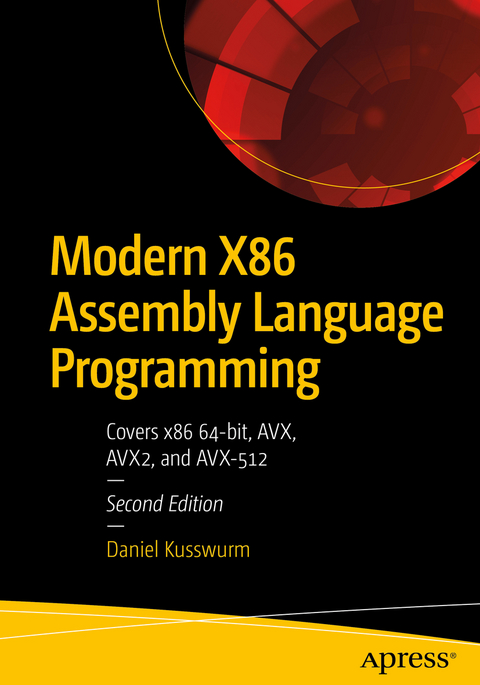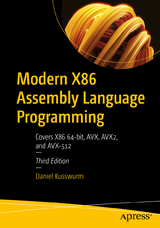
Modern X86 Assembly Language Programming
Apress (Verlag)
978-1-4842-4062-5 (ISBN)
the updated aspects of the x86 instruction set that are most relevant to application
software development. This book covers topics including x86 64-bit programming and
Advanced Vector Extensions (AVX) programming.
The focus in this second edition is exclusively on 64-bit base programming architecture
and AVX programming. Modern X86 Assembly Language Programming’s structure and
sample code are designed to help you quickly understand x86 assembly language
programming and the computational capabilities of the x86 platform. After reading
and using this book, you’ll be able to code performance-enhancing functions andalgorithms using x86 64-bit assembly language and the AVX, AVX2 and AVX-512
instruction set extensions.
What You Will Learn
Discover details of the x86 64-bit platform including its core architecture, data types,
registers, memory addressing modes, and the basic instruction set
Use the x86 64-bit instruction set to create performance-enhancing functions that
are callable from a high-level language (C++)
Employ x86 64-bit assembly language to efficiently manipulate common data types
and programming constructs including integers, text strings, arrays, and structures
Use the AVX instruction set to perform scalar floating-point arithmetic
Exploit the AVX, AVX2, and AVX-512 instruction sets to significantly accelerate the
performance of computationally-intense algorithms in problem domains such as
image processing, computer graphics, mathematics, and statistics
Apply various coding strategies and techniques to optimally exploit the x86 64-bit,
AVX, AVX2, and AVX-512 instruction sets for maximum possible performance
Who This Book Is For
Software developers who want to learn how to write code using x86 64-bit assembly language. It’s also ideal for software developers who already have a basic understanding of x86 32-bit or 64-bit assembly language programming and are interested in learning how to exploit the SIMD capabilities of AVX, AVX2 and AVX-512.
Daniel Kusswurm has over 30 years of professional experience as a software developer and computer scientist. During his career, he has developed innovative software for medical devices, scientific instruments, and image processing applications. On most of these projects, he successfully employed x86 assembly language to significantly improve the performance of computationally-intense algorithms or solve unique programming challenges. His educational background includes a BS in electrical engineering technology along with an MS and PhD in computer science.
IntroductionChapter 1 – 64-bit ArchitectureChapter 2 – 64-bit Architecture Programming – Part 1Chapter 3- 64-bit Architecture Programming – Part 2Chapter 4 – Advanced Vector Extensions (AVX)Chapter 5 – AVX Programming – Scalar Floating-PointChapter 6 – AVX Programming – Packed Floating-PointChapter 7 – AVX Programming – Packed IntegersChapter 8 – Advanced Vector Extensions 2 (AVX2)Chapter 9 – AVX2 Programming – Packed Floating-PointChapter 10 – AVX2 Programming – Packed IntegersChapter 11 – AVX2 Programming – Enhanced Feature Set InstructionsChapter 12 – Advanced Vector Extensions 512 (AVX-512)Chapter 13 – AVX-512 Programming – Packed Floating-PointChapter 14 – AVX-512 Programming – Packed IntegersChapter 15 – Optimization Strategies and TechniquesChapter 16 – Advanced Programming ExamplesAppendix A
| Erscheinungsdatum | 28.12.2018 |
|---|---|
| Zusatzinfo | 96 Illustrations, black and white; XXI, 604 p. 96 illus. |
| Verlagsort | Berkley |
| Sprache | englisch |
| Maße | 178 x 254 mm |
| Gewicht | 1178 g |
| Themenwelt | Mathematik / Informatik ► Informatik ► Programmiersprachen / -werkzeuge |
| Informatik ► Theorie / Studium ► Algorithmen | |
| Informatik ► Theorie / Studium ► Compilerbau | |
| Schlagworte | 32-bit • 64-Bit • Assembly • avx • avx-512 • Code • language • programming • SIMD • source • Streaming • x86 |
| ISBN-10 | 1-4842-4062-6 / 1484240626 |
| ISBN-13 | 978-1-4842-4062-5 / 9781484240625 |
| Zustand | Neuware |
| Haben Sie eine Frage zum Produkt? |
aus dem Bereich



